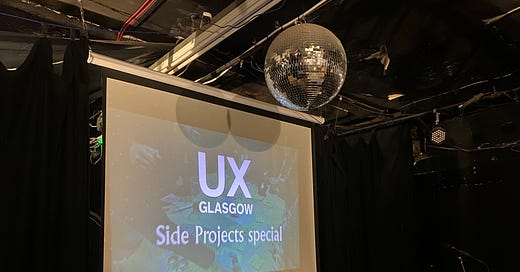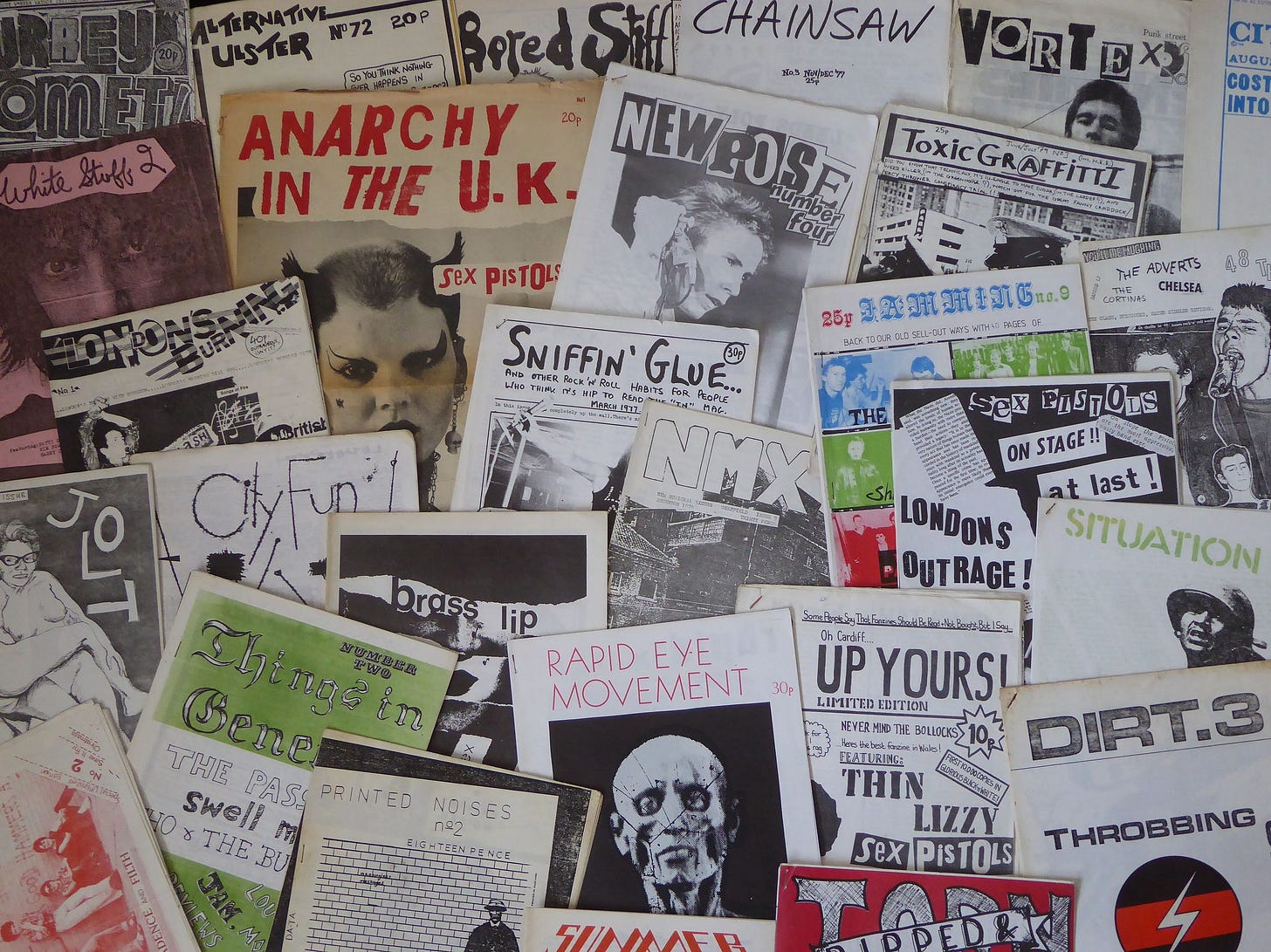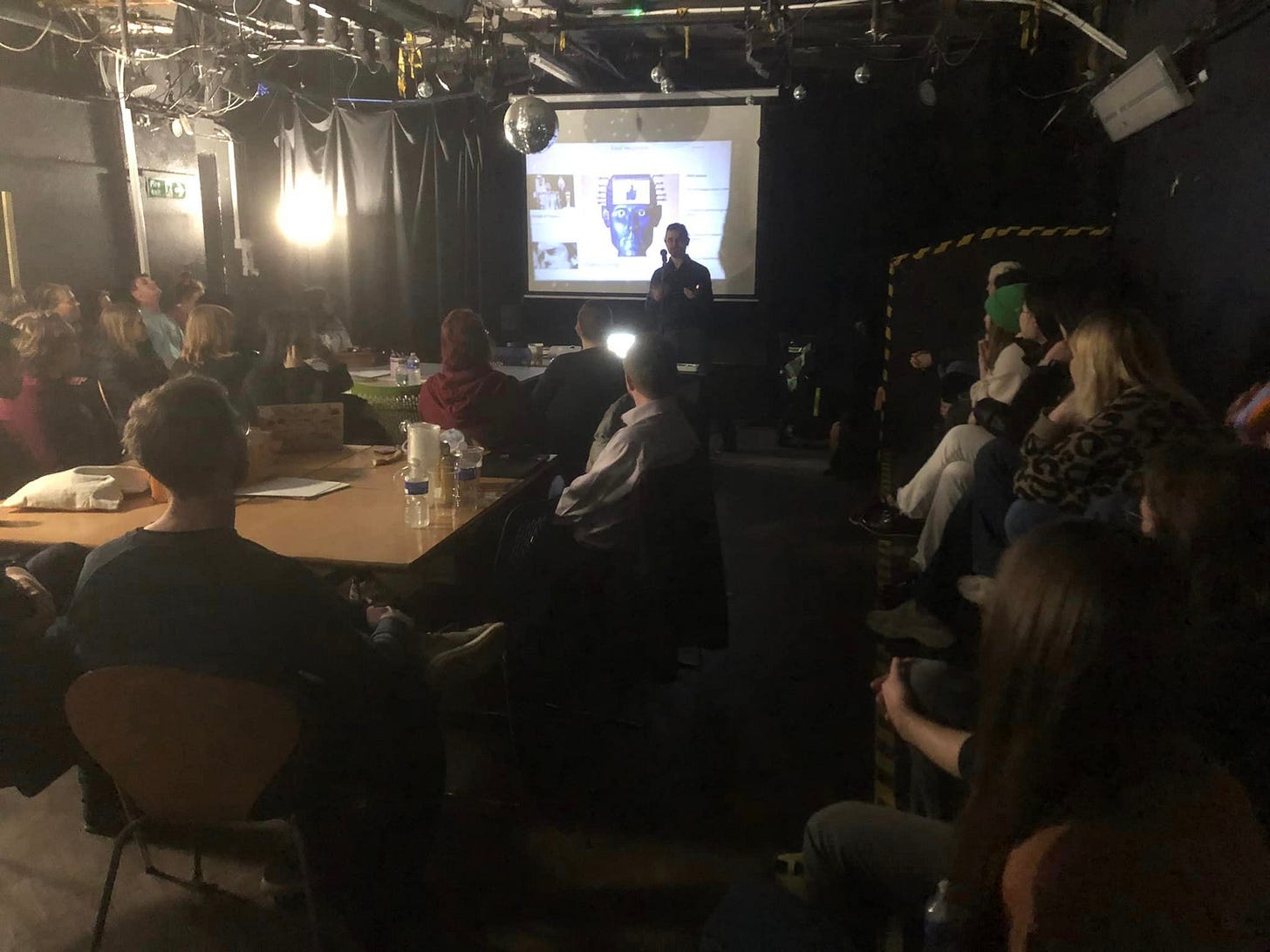The Side Project is Dead, Long Live The Side Project
A short talk to introduce the UX Glasgow event about Side Projects.
When Bobby got a desk at The Space and mentioned that there was a venue for holding events, we thought it would be the perfect opportunity to talk about DIY side projects. The Space is a non-profit community venue that supports people being creative, whereas the user experience design world has become incredibly corporate over the last decade. I was curious to learn what kind of fun projects people in the community do on the side.
I am constantly inspired by the zine-making creativity of the punk era. The web provides an incredible set of tools to self-publish and express yourself. My own career as a designer began, like many, by viewing source, copying code, and adapting it to my needs. I learned enough by tinkering around to do a few freelance projects and then had enough skills to get a job.
Last year, I set myself the challenge to write an article every week for my blog. I wasn't paid to do this and I didn't set up any paywall, but I knew that by publishing them I would go out of my comfort zone, improve my writing, and learn something new. Who knows where it might lead? I have been commissioned to write a review for a magazine and had one of my pieces displayed in an exhibition. This is the beauty of side projects: they are opportunities to experiment without the pressure of having to make it pay.
However, when I started to ask in the community for interesting side-projects, I found barely anything. 15 years ago, the web was full of people putting together fun little side projects to solve problems. Nowadays, not so much. The side project, it seems, is dead and I was curious to know what killed it.
The main reason, I think, is economic. To have a side project implies that you have a main thing that is stable and doesn't take too much of your energy. In an era of precarious work and patchwork careers, the idea of having a main job has disappeared. The freelancer spins so many plates that they can’t hope to take on a speculative side project. People go from contract to contract, job to job. How many people here have worked for one company for more than five years? Side project time, also known as 20% time, was a famous benefit of working for Google; the idea was that you could go to work and be creatively fulfilled.
Work has transformed over the last decade. Inspired by the change-the-world passion of silicon valley, companies encourage workers to spend more and more time in work. There are beers in the fridge and emails to answer on the phone. Work never ends and people expect to be happy there. A rewarding career is considered a necessary part of a self-actualised life. It is rare for billionaires to give up and spend their lives on the beach: they want to work with purpose. This attitude to work is historically recent.
If we go further back, things were even less money-oriented. The scientific revolution was built on the curiosity of amateurs, generally privileged men who didn't have to work, but not always. Michael Faraday was a delivery boy. Alfred Nobel's family were penniless.
We spend a lot of time staring at screens, consuming entertainment. We are no longer, as George Orwell wrote, a nation of hobbyists: "stamp-collectors, pigeon-fanciers, amateur carpenters, coupon-snippers, darts-players, crossword-puzzle fans" — all those random pursuits that rely on having time and attention to spare. My friend Tim thinks we still are:

A side project, though, is more work-oriented than a hobby, tending to teach skills. In recent times, it has itself been replaced by the side hustle, which explicitly aims at making money doing as little work as possible. Entire websites and YouTube channels are devoted to side hustles like dropshipping and reselling clothes on eBay. Wherever there is love and duty, capitalism will find a way to turn it into a side hustle.
As Karl Marx said of the bourgeoisie:
“It has drowned the most heavenly ecstasies of religious fervour, of chivalrous enthusiasm, of philistine sentimentalism, in the icy water of egotistical calculation. It has resolved personal worth into exchange value.”

Every activity nowadays gets instrumentalised and turned into a podcast or a YouTube channel in the hope of becoming an influencer. For a DIY enthusiast, who believes in doing things for love rather than money, it is all very depressing.

Nevertheless, I still think — based on personal experience of having made magazines, done a blog, and helped build the
community — side projects are worth pursuing and hope that tonight's talks can encourage you to get ideas out into the world and learn something new.My personal tips for making them work are:
1. Keep it simple
Have a clear, simple goal of what you want to achieve. Finish it and put it out into the world. Perfectionism is the enemy of progress, so try and publish the simplest version you can. Don't talk about it too much and build up too much expectational debt. Think of it all as a learning process. Sue Smith, one of our speakers tonight, showed us how to make simple projects with Glitch.
2. Iterate
You may not want to carry on after version one. But try and identify simple iterations that can help you move forward. Neil McKillop, our other speaker, is an advocate of open source which often works on this iterative principle.
3. Trust your gut
It is easy to get into the habit of doing what other people think is worthwhile, but you have to trust your gut, otherwise you can easily get lost in a sea of feedback.
4. Follow through
It is incredibly satisfying to publish things, strengthing your identity as someone who can get things done and who isn't too precious.
5. Make it sustainable
Do you really have the hours in the day to dedicate to this side project? What are you prepared to give up to make it happen? Remember that life will get in the way. Don't overcommit!
For more on enjoying hobbies for the hell of it, check out Brad Frost’s blog post.











